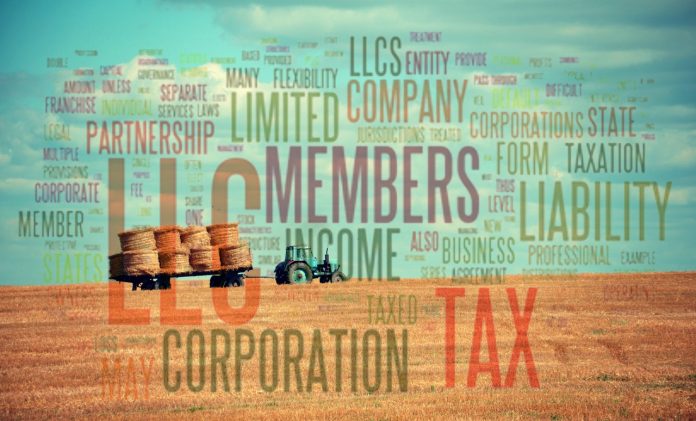The structure you choose for your farm business influences daily operations, how decisions are made and the responsibilities of owners. Different entities have tax and legal implications that can benefit or have negative consequences on your farm.
Farmers form businesses under one of the five basic business structures: sole proprietorship, limited liability company, partnership, corporation or cooperative. The difference between entities boils down to ownership, governance, liability, taxes and farmers’ short and long-term goals.
To choose the best business structure for your farm, ask yourself Who owns the business? Who makes business decisions? What are the liability concerns? How is income taxed? What are the short and long-term goals for the farm?
Sole proprietorship
Sole proprietorship is a simple business structure that is owned by one farmer. Thirty-five percent of livestock farms and 36 percent of crop farms are sole proprietorships.¹ In a sole proprietorship, the farmer maintains complete control of the business, including assets and profits. The farmer is personally responsible for debts and liabilities the business incurs. Business income is reported on the farmer’s personal return.
If sold a sole proprietorship does not transfer directly to a new owner. In order for the farmer to transfer assets, the new owner must establish a new entity to receive the assets. Farm debts do not transfer to the new owner.
Limited liability company (LLC)
One or more farmers can form an LLC. Corporations, other LLCs and foreign entities can also form an LLC. The owners of the LLC are called members. An operating agreement between members governs daily operations.
The limited liability company structure is gaining popularity with farmers. Thirty-five percent of animal operations and 26 percent of crop farms are LLCs. Farms that are LLCs have higher gross sales than those with other business structures.¹
LLCs provide farmers with some protection of personal assets if the LLC defaults on debt or is sued, however, members’ personal assets are not protected in the case of wrongful action.
The federal government does not tax a limited liability company as a separate entity. Members of the LLC are considered self-employed by the government. Each member files federal income tax and makes self-employment tax contributions on their personal return. Business losses pass through to members’ personal taxes.
The LLC must be dissolved when a member leaves. All financial obligations must be met before the company is dissolved.
Partnership
Two or more farmers can form a partnership. The role of each partner and their contributions to the farm business is outlined in a legal partnership agreement. One farmer may contribute land and another labor. They share profits and losses according to percentages agreed upon by both partners.
Partners are personally responsible for business debts and liabilities. The partnership does not pay income tax as an entity. Each partner pays taxes on his share of income earned.
Partnerships are uncommon in agriculture. Only six percent of livestock and eight percent of crop farms are partnerships.¹
Corporation
State laws dictate who can form a corporation and how it is formed. In Ohio, one or more farmers can form a corporation. Corporations are owned by shareholders. The corporation, not the shareholders, is legally liable for business actions.
Corporations can be complex and expensive to form, but the structure offers several benefits. A major benefit is greater flexibility to raise funds through stock and outside investors. Another benefit is that unlike an LLC, the corporation can stay in operation if a shareholder leaves.
Fifty-eight percent of tree farms, 24 percent of livestock and 30 percent of crop farms are corporations. In recent years there has been a rise in farms formed as non-profit corporations. Farmers form non-profits to achieve a purpose other than profit, such as education or food justice.
Corporations are designated as S or C. The difference is in how the corporation is taxed. An S-Corp receives pass-through taxation. A C-Corp pays income taxes on profits. Sometimes C-Corps are double-taxed a second time when dividends are paid to shareholders.
Cooperative
Two or more farmers can form a cooperative. A cooperative is owned and controlled by its members. Farmers form cooperatives to meet a mutual need, like reducing costs, gain access to larger markets or to co-market farm products. Although some cooperatives allow non-members to utilize services, the purpose of a co-op is to serve its members. The business structure is highly adaptable. It can fit family farms, small groups of local growers or several hundred farms like Dairy Farmers of America cooperative.
All co-op members have equal voting power. Duties, responsibilities and operational procedures are outlined in by-laws and agreed upon by members. In large cooperatives, members elect a board of directors to act on behalf of the shareholders and guide the business’s direction.
Co-op income passes through to members’ personal taxes. Members can leave a cooperative without dissolving the business.
¹ Backman, C. “Business structure for small farms: A quick guide”, 2015. Washington State University Extension. Retrieved May 28, 2017 from https://research.libraries.wsu.edu/xmlui/bitstream/handle/2376/5363/FS178E_FINAL.pdf?sequence=1&isAllowed=y.












